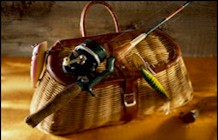Clad in a
wintry cloak of snow and ice, the fertile, spring-fed reach of the Bear
River southwest of Grace is apparently healthy and bursting with hungry
hatchery-reared rainbows.
I know this because a week or so ago, I
tromped through a good foot and a half of powder along the river, up
past the first set of falls, to a series of pools that call to me when
the regular stream season closes at the end of November. Thanks to Utah
Power and Light ó the corporation that allows access to the area ó and
the Department of Fish and Game, the Bear River through Black Canyon
remains open all year, providing a winter retreat for stream fishers
flushed from the banks of the Henryís Fork, the South Fork and the upper
Portneuf.
But itís no picnic. The Gem Valley gets
its share of winter ó iced-up guides, frozen fly reels and 10 numb toes
will attest to that after a December day on the water. Nevertheless,
winterís the prime time to visit Black Canyon, in my opinion. During the
summer months, I prefer to venture into the backcountry in search of
wild trout and some solitude. During the snowy months, solitude aplenty
can be found between the walls of Black Canyon, and the rainbows can be
coaxed to a fly with some regularity.
I visited Black Canyon last week between
storms, breaking a squeaky trail through the unbroken crust of snow in
the process. Enjoying whatís become a rare sunny day, my old dog Spooner
and I had the river to ourselves ó a rarity for flyfishers who visit the
same stretch of water during warmer months.
The sunshine, while welcomed by the soul,
kept the riverís midges from hatching out. Generally, during a cloudy
winter day, thousands of tiny black bugs will plop from the surface of
the Bear River, enticing the resident rainbows to rise in search of a
meal. Itís a wonderful stretch of water to visit on a cloudy day armed
with a fly box full of Griffithís Gnats. On a clear day, though, a fly
fisherman must take a hint from Jerry Rice and go deep.
But sinking a fly in the crystal waters
of Black Canyon is a risky proposition. Anyone visiting the Bear can
tell just by looking that the river is a moss-lined quagmire, even
during the cold winter months. On nearly every cast, a weighted fly will
pick up a tail of moss.
Small sacrifice, however, for if an
angler is lucky enough, as I was last week, heíll stumble on some deep
pools holding hungry trout willing to strike a dead-drifted nymph
imitation.
I use an olive green attractor tied on a
size 14 scud hook and equipped with a heavy tungsten bead head. To give
the fly a little swimming action, I tie in a short olive maribou tail
and a couple strands of flash material. The body is dubbed and
reinforced with thin brass wire. The thorax consists of peacock herl
wrapped right behind the shiny tungsten bead. Itís easy to tie and very
effective.
While the heavy fly works in all kinds of
colors, during the winter months the olive dubbing or a Canadian brown
mohair yarn version seem to be most attractive to Black Canyonís
rainbows. Donít bother with a sink-tip line ó a full floating line is
adequate. With the heavy fly at the end of the leader, the fly line acts
as a poor manís strike indicator.
Casting directly upstream into one pool
no larger than the average coffee table, I was able to reel in five
rainbows ó I had a strike on nearly every cast into the hole. The
largest fish was about 15 inches and the smallest measured about 10
inches. I cast the heavy fly to the head of the pool, and left just
enough tension on the line during the downstream drift to recognize a
subtle strike ó the fish werenít as aggressive as they might have been
on a warmer day.
In all, the sunny day spent trudging
through the snow along the riverís bank was one of the best Iíve spent
at Black Canyon, winter or not. Of course, I had to struggle with iced
guides and a frozen fly reel. Winter fly fishing is for the hardy. There
are frequent intervals due to ice in the guides, mossy flies and an an
occasional bout with a fly reel that freezes during a gust of
particularly chilly air.
But, as I scanned the winter landscape of
the Bear as it slices through the lava walls of Black Canyon, there was
no need to count other fishermen. Old Spooner and I had the trout to
ourselves.





